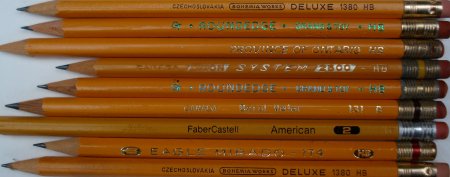
Found in a drawer – nine yellow office pencils, sharpened and ready to use.
The pencils are marked:
1. Czechoslovakia Bohemia Works Deluxe 1380 HB
As Czechoslovakia split up in 1993, this pencil is an interesting historical item. I seem to recall Bohemia Works pencils being available some years ago.
2. Roundedge Grand & Toy HB
Dating from the 1880s, Grand & Toy used to be the leading Canadian office supply chain. They still exist, but are now owned by the OfficeMax chain. Today, nearly all hexagonal pencils have rounded edges, but I’m wondering if this line was introduced at a time when the name may have been a selling point.
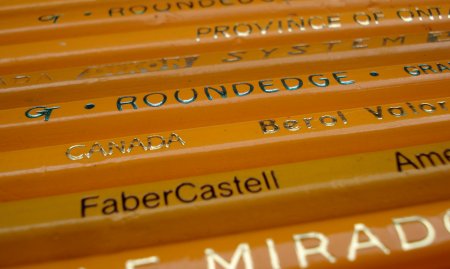
3. Province of Ontario HB
A government office pencil that went astray?
4. Canada Dixon System 2500 – HB
It sounds like a fictional mainframe computer to me – the “System 2500”.
5. Canada Berol Valor 131 B
There is a Shaeffer Valor pen on the market, but I was unaware of this pencil brand.
6. FaberCastell American 2 (Also the impression “U.S.A. Bonded”)
I believe the brand still exists in the Sanford lineup. This pencil would be post-Eberhard Faber, pre-Sanford in the timeline. Note that “FaberCastell” is styled as a single word.
7. Eagle Mirado 174 HB (The reverse has the impression “Procede “Chemi-Sealed” R Bonded Canada”)
The Mirado name is of course still around today.
And two pencils are duplicated.
So we have one pencil from the former Czechoslovakia, one from the US, and three from the Canadian subsidiaries of US firms. An interesting assortment.


